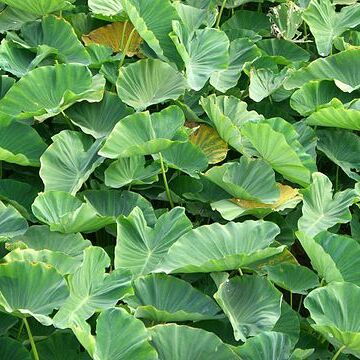Herbs, seasonally dormant or evergreen, small, medium sized, or gigantic, latex-bearing. Stem either a hypogeal, subglobose or subcylindric tuber or mostly epigeal, massive. Leaves several, rosulate in acaulescent plants, forming a terminal crown in arborescent species. Petiole glabrous, sometimes strikingly glaucous, rarely pubescent, sheath rather long; leaf blade peltate, ovate-cordate to sagittate-cordate, abaxially glabrous, glaucous, pruinose, rarely pilose; posterior lobes rounded, shortly to almost entirely connate; basal ribs well developed, primary lateral veins pinnate, forming submarginal collective vein, 1 or 2 marginal veins also present, secondary and tertiary laterals arising from primaries at a wide angle, then arching strongly toward leaf margin and forming inconspicuous interprimary collective veins, higher order venation reticulate. Inflorescences 1 to many per each floral sympodium, appearing with leaves; peduncle mostly shorter than petioles. Spathe constricted between tube and limb, sometimes with a second weaker constriction above male zone of spadix; tube persistent, enlarging in fruit and then splitting open irregularly from apex, with convolute margins, usually much shorter than limb, ovoid or oblong; limb either remaining erect, and ± furled, or opening and then reflexed at anthesis, later deciduous, white or yellow, very narrowly lanceolate to oblong or boat-shaped. Spadix sessile, shorter than spathe; female zone short, separated from male by narrower zone of sterile male flowers or contiguous with male zone; male zone cylindric to fusiform; terminal appendix erect, ± smooth, narrowly conic to fusiform or subulate, sometimes reduced to a small, mucronate stub, or absent. Flowers unisexual, naked. Ovary ovoid or oblong, 1-loculed; ovules many, hemiorthotropous; funicles relatively long; placentae 2-5, parietal; stylar region short, narrowed or not, sometimes ± absent; stigma disciform-capitate or weakly lobed. Interpistillar staminodes present in some species, these weakly clavate, equaling associated pistil; interfloral synandrodes (where present) depressed obpyramidal, laterally compressed, truncate. Male flowers 3-6-androus; stamens connate into ± truncate synandrium; thecae lateral, oblong-linear, dehiscing by apical pore. Infructescence erect or declined by flexing of peduncle. Fruit a greenish to whitish or dull orange, obconic or oblong, strongly fruit-smelling berry, many seeded; stigma remnants persistent. Seed tiny, ovoid to ellipsoid; testa thickish, costate; embryo axile, cylindric; endosperm copious.
More
Herbs, wetland [or terrestrial]. Stolons with nodes produced at or near surface; corms underground [aboveground], tuberous. Leaves appearing before flowers, several, clustered apically, erect; petiole usually longer than blade; blade green to dark green or glaucous blue-green adaxially, simple, peltate, ovate-or sagittate-cordate, basal lobes rounded, apex mucronate; primary lateral veins parallel, secondary lateral veins netted. Inflorescences: peduncle erect, shorter than leaves, apex not swollen; spathe tube green; spathe blade orange, opening basally and reflexing apically at anthesis to expose spadix; spadix slender, tapering, usually terminated by sterile appendage. Flowers unisexual, staminate and pistillate on same plant; pistillate flowers covering base of spadix, staminate flowers apical, sterile flowers between pistillate and staminate flowers; perianth absent. Fruits greenish to whitish or red. Seeds 0--5(--35), mucilage probably present. x = 7.
Small to massive, often stoloniferous and colony-forming herbs; stem a short condensed subterranean rhizome to massive, starch-filled and sometimes subarborescent. Leaves: several together; blade always peltate, usually ± glaucous, secondary venation sometimes forming well-defined interprimary collective veins. Inflorescences usually several together, physiognomically axillary, in a sequence centripetal to stem, sometimes highly perfumed; spathe constricted, with lower part persisting into fruit, and limb deciduous after anthesis; spadix shorter than spathe; female zone with naked pistils often sporadically accompanied by staminodes; sterile interstice attenuate and corresponding with spathe constriction; male zone of rhombo-hexagonal synandria; appendix present to vestigial; ovules numerous on parietal placentas. Fruit exposed by dehiscent spathe base, greenish to orange, fragrant, containing many small seeds.
Erect, monoecious, tuberous, perennial herbs. Leaves peltate; laminae ovate-cordate, tip usually pointing down; petiole long. Inflorescences several together near apex of plant, pedunculate. Spathe tubular below, constricted at center, expanded above. Spadix < spathe; female flowers at base, separated from male flowers by a short zone of sterile flowers, with or without sterile terminal appendage. Berry white to greenish. Spp. c. 8 of tropical Asia, Malaysia and the Pacific. Adventive sp. 1.
Includes the important food crop plant Taro (Colocasia esculenta), especially in the Pacific. Taro is a staple or subsistence food for many people, as well as being traditionally used as a medicinal plant; e.g. see Wang (1984), Lim (2015), Pereira et al. (2015), Pawar et al. (2018), Rashmi et al. (2018), Sudhakar et al. (2020), and references therein. There are many taxa, including cultivars with large, blackish or variegated leaves, grown as ornamentals.

